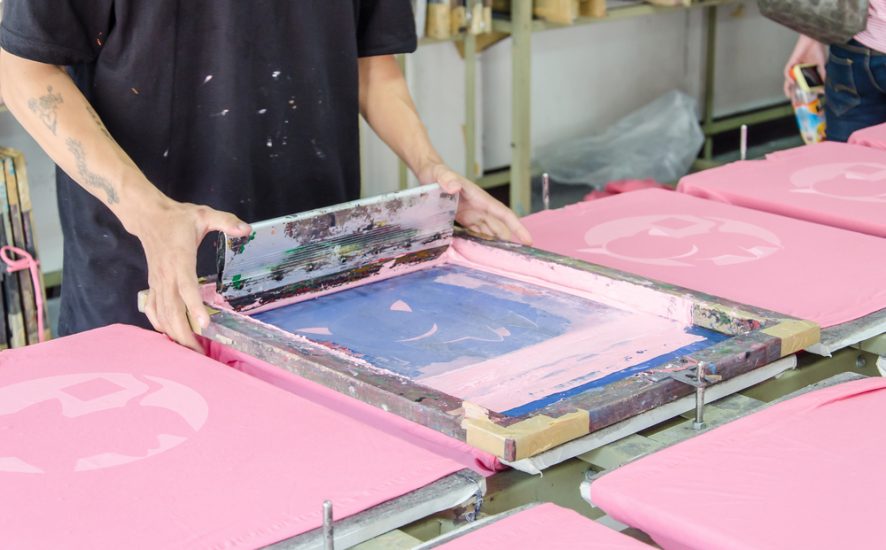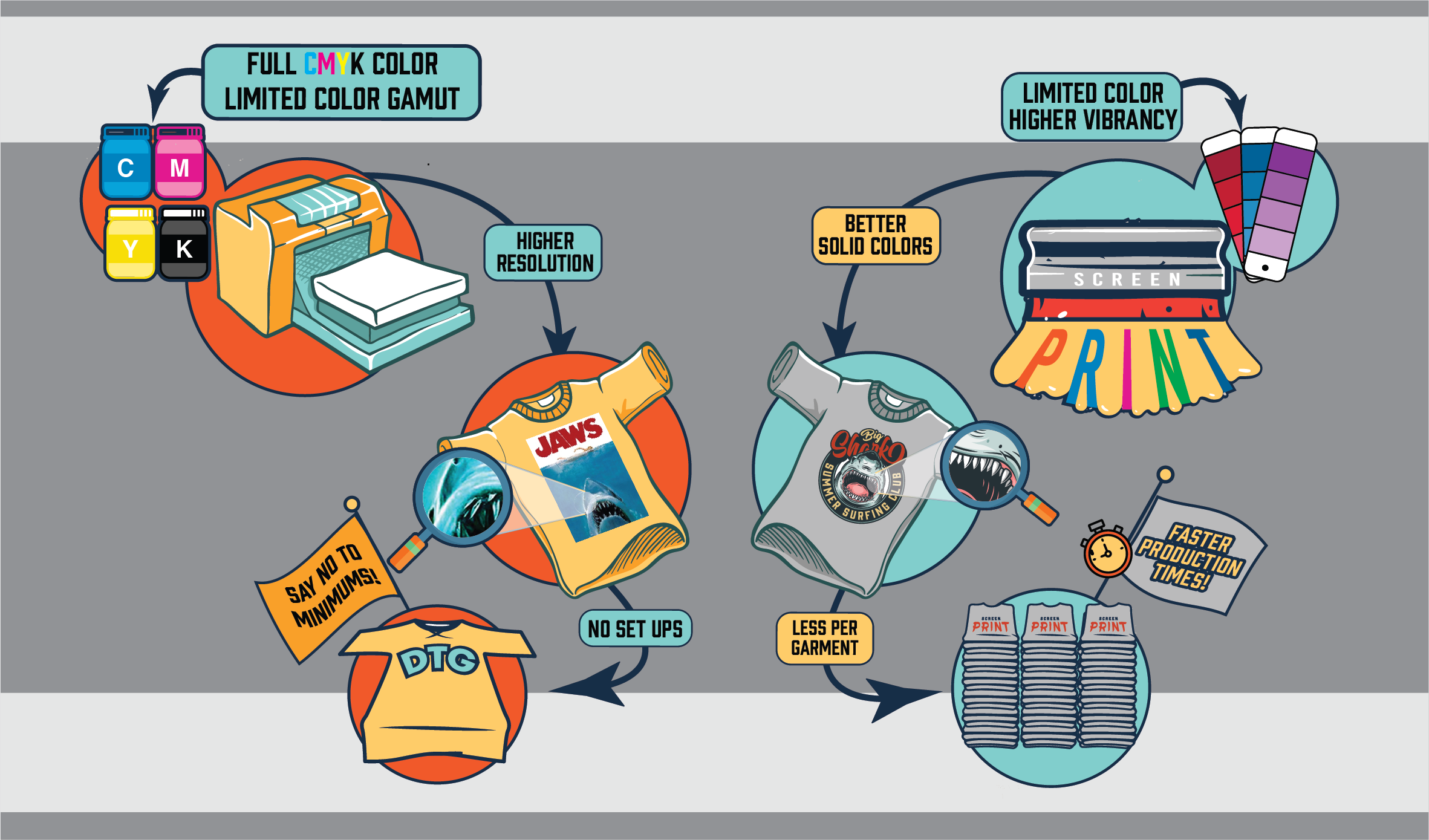Tx Tees - Truths
Some Known Facts About Tx Tees.
Table of ContentsTx Tees Fundamentals ExplainedFacts About Tx Tees RevealedThe 6-Second Trick For Tx TeesThe smart Trick of Tx Tees That Nobody is DiscussingTx Tees - The FactsNot known Incorrect Statements About Tx Tees The Buzz on Tx Tees
Add up various other costs, like the number of utilities it takes to run the shop and the expense of ink and emulsion per layout. Take the print below.The solution should just be a couple of cents since you 'd just need to coat one display for this work. Just how much should you charge per t shirt to make a profit? Usually, printers attempt to make up to 45% earnings on a print task. Here's a table to assist you determine that: total expense per item percent of desired revenue as a decimal (example:.25 or.45) earnings made per product per task Now let's discuss the productivity of DTF.

With DTF, you can print a handful of t shirts, or simply one. Use the very same calculator as the section above to determine exactly how much profit you would certainly make utilizing DTF transfers. Compare the costs and profits to whichever method speaks finest to your setup and process. Both screen printing and DTF have their specific niches on the planet.
All About Tx Tees
The most effective means to understand? Ask around and see what print shops like yours are doing. t-shirt printing. Try both out and see which you like better
When you're picking what kind of printing method to utilize for printing your art work styles on your garments, it is essential that you know the distinctions between these 2 methods so you can make best use of results while decreasing prices. Display printing is one of the most commonly used technique for publishing designs on fabrics.
DTG printing is likewise called area or straight to garment printing because it prints just what is required rather of making a display as screen printers do. https://triberr.com/txtees02. Screen printing functions by screen filler squeegee display printing ink display mesh display, then moving the photo to garment using warmth and/or pressure
The DTG printer utilizes special dye-sublimation inks that are applied right into a pre-designed image by an electronic printing system. The inks enter into the textile, enabling vivid shades and phenomenal information. It's also recognized as place or direct to garment printing because it prints just what is needed as opposed to making a display as display printers do.
Tx Tees Things To Know Before You Get This
First, it's much quicker - you can publish a fullcolor image in minutes, as opposed to hours for screen printing. Second, there's no set up time or expenses entailed - you can publish any type of design you like, without having to develop a screen initially. Third, there's no waste - since screen printers display print one style each time, they have to screen each shade separately.
The paper is really pricey and can only be utilized when. Once it's printed on, it has to be thrown out. - The first purchase rate is lower than the upfront financial investment of DTG printers- You can publish multi-color designs one display at a time rather than needing to print each color independently like DTG printing.

The Buzz on Tx Tees
Instead of utilizing display mesh as screen printers do, dye sublimation printers use laser innovation to move your images onto garments or paper. A warm procedure transfers the color from its solid-state straight right into the gas stage which subsequently fuses it onto textile substratums when they are swiftly warmed to heats under high pressure.
Sublimation printing is environmentally friendly. It utilizes much less water than screenprinting, and because it does not include the usage of damaging solvents, it's secure for all kinds of clothing. The color sublimation inks are also odor free when treated, unlike screen printers that use hazardous chemicals throughout the display printing process that leave behind an unpleasant odor.
They additionally conserve cash on pricey devices like direct exposure units because color sublimation printers don't require a UV exposure system or a flash remedy oven that is typically made use of in screen printing (screen printer). What is straight to garment printing (DTG Printing)? DTG printing is a digital screenprinting process that publishes straight onto material making use of specialized inkjet printers
The Basic Principles Of Tx Tees
DTG printing offers many benefits over typical screenprinting, consisting of the ability to print photo top quality images, better color vibrancy, and the capability to publish designs on darker textiles. DTG printers work by heating up the textile ink till it becomes a gas. The gas then permeates the fabric, bonding with the fibers to produce a permanent print.

Display printers just prepare their display then begin publishing till they run out of item or ink.- There is a wide variety of experienced display printers all over the globe, which can be valuable for novices. - It's a slower process - display printers commonly need to wait for the ink to completely dry prior to they can print the following color- Screen printers require hand-operated labor, so there's a higher knowing curve and it takes longer to create a top notch design- Display printing isn't as precise as DTG printing, so you may get some "bleeding" of shades from one component of the photo onto one more if not done correctly.
9 Simple Techniques For Tx Tees
Instead of making use of screen mesh as display printers do, dye sublimation printers use laser technology to move your images onto garments or paper. A heat procedure transfers the color from its solid-state directly into the gas phase which in turn integrates it onto textile substratums when they are swiftly heated up to high temperature levels under high stress.
Sublimation printing is green. It uses much less water than screenprinting, and due to the fact that it does not involve using hazardous solvents, it's secure for all sorts of apparel. The color sublimation inks are also odorless when cured, unlike screen printers that use damaging chemicals during the screen printing process that leave behind an unpleasant smell.
They additionally save cash on costly devices like direct exposure units since color sublimation printers don't require a UV direct exposure system or a flash treatment oven that is usually utilized in screen printing. What is direct to garment printing (DTG Printing)? DTG printing is a digital screenprinting process that prints straight onto textile making use of specialized inkjet printers.
The smart Trick of Tx Tees That Nobody is Talking About
DTG printing provides lots of advantages over traditional screenprinting, consisting of the ability to publish photo quality images, higher shade vibrancy, and the capacity to print layouts on darker materials. DTG printers function by warming the textile ink up until it develops into a gas. The gas after that permeates the material, bonding with the fibers to produce a permanent print.